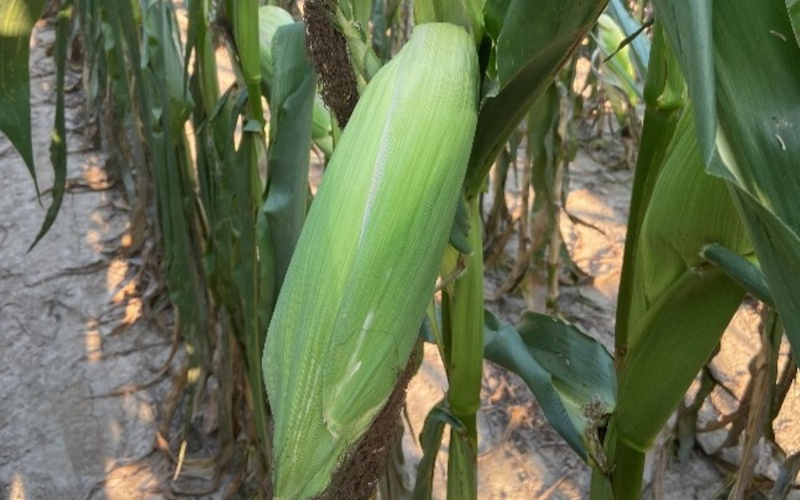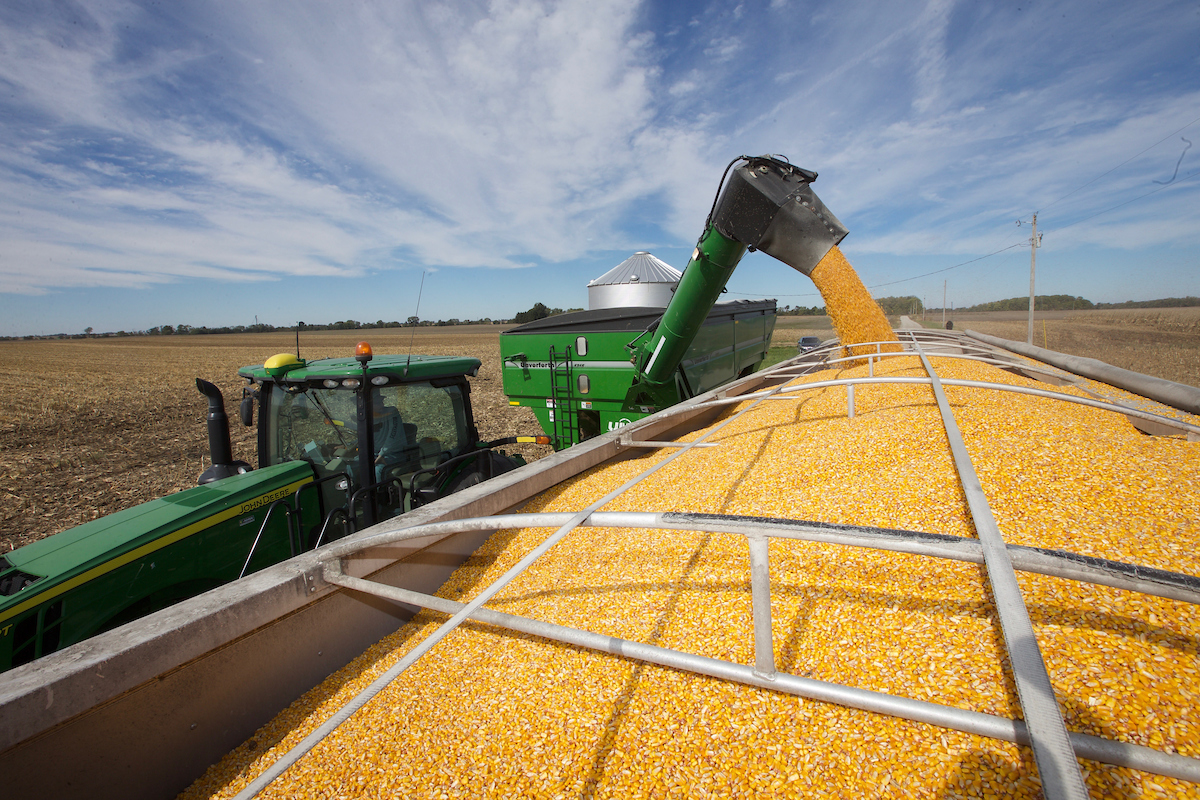Assessing Hail Damage in Corn
Recent storms which crossed Indiana brought welcome rains to current dry conditions, yet were not without additional challenges, which includes hail damage. When first assessing a field with hail damage, it can often be depressing and discouraging. However, it is important to be patient when assessing the damage and that the observed damage often looks worse than it actually is.
There are three primary ways that a corn plant can be impacted by hail damage 1) plant stand reduction caused by plant death, 2) leaf area reduction caused by hail damage defoliation to the leaves, and 3) direct damage to the plant (e.g., stalk) and ear. Overall, the impact of hail damage to corn is largely dependent on what stage of development the corn plant is in when the hail damage occurs. Nearly all of the corn across Indiana was in the vegetative growth stages with recent storms, yet growth stages varied across the state with differences in planting dates and the impact of drought conditions on the growing plants. In general, a corn plant that is in a stage of development prior to the V6 growth stage (6 visible leaf collars) will experience minimal impact from hail damage due to the plant’s growing point being below the ground. However, as the growing point elevates above the soil surface and the plant progresses through the vegetative growth stages and to pollination, the plant becomes more susceptible to hail damage.
When assessing plant stand reduction caused by hail damage, which is often most common in young corn, it is important to wait 3-5 days to assess plant survivability and determine if plants are showing any noticeable recovery. Plant recovery can be identified as the expansion of new leaves and green leaf area from the whorl of the plant. It is also important to understand that corn yield losses caused by reductions in plant stand are not directly proportional to the number of missing plants. This is due to neighboring plant compensation through kernel number increases and/or the development of an additional ear. For example, when examining corn grain yield response to plant populations (https://www.agry.purdue.edu/ext/corn/news/timeless/PlantPopulations.html), final plant population differences between 28,000 to 35,000 plants per acre only result in a yield change of +/- 1 bushel.
The primary risk of yield loss in corn due to hail damage is due to leaf defoliation. Loss of green leaf area can reduce plant photosynthesis. However, when assessing leaf loss, it is important to consider only leaves which are completely lost, dried, or brown. Leaves which are tattered and torn, yet still attached and green still can contribute to yield production. The leaf loss chart on page 86 of the USDA-FCIC Corn Loss Adjustment Standards Handbook (2023) can help provide an estimation of yield loss due to leaf defoliation and highlights how total yield loss is largely dictated by which growth stage the plant is at when the damage occurs. The same table is reproduced on pp. 59-60 in Purdue’s ID-179 Corn & Soybean (2023) Field Guide if you have one of those in your vehicle. Before you use that table, though, be sure you understand how the hail adjusters define leaf stages because their method differs from that most agronomists use (Nielsen, 2019). Typically, their method of leaf staging will be 1-2 stages greater than the leaf collar method (e.g., 11-leaf stage in the table = V9 by the leaf collar method). Based on the table, 100% leaf loss on an 8-leaf plant will result in only an 11% reduction in yield, whereas 100% leaf loss on a tasseled plant will result in a 100% reduction in yield.
On older plants, hail can also cause stalk bruising, whorl damage and/or physical damage to the kernels on the ears. Severely bruised corn stalks from hail can limit the plants’ ability to translocate water and nutrients and/or cause the growing point region to die. Therefore, it is often important to split some stalks following a hail damage event to assess any potential damage and damage severity to the stem tissues and/or growing point. In addition, severe whorl damage can also restrict the expansion of whorl leaves and increase plant susceptibility to bacteria invasion caused by soil water splashing from heavy rainfall. Determining the exact amount of yield loss caused by stalk bruising, whorl damage, and/or physical damage to the kernels can be challenging and difficult to determine.
Lastly, one question that always arises following hail damage in corn is “should I apply a fungicide?” and the answer is no (Malvick, 2016). There is a common misconception that foliar fungicides will improve crop recovery and yield following hail damage. This is largely not true due to bacterial diseases being the primary invader of corn following hail, which foliar fungicides are unable to control. In addition, a defoliated crop is less likely to effectively take up fungicide.
Additional Resources:
Coulter, J., and S. Naeve. 2021. Wind and Hail Damage on Corn. Univ. of Minnesota Ext. https://extension.umn.edu/growing-corn/wind-and-hail-damage#how-leaf-loss-affects-yield-444312 [URL accessed July 2023]
Lindsey, A., and P. Thomison. 2022. Corn Yield Response to Damage from Strong Storms. Bull. AC-1054. Ohio State Univ. Ext. https://ohioline.osu.edu/factsheet/ac-1054 [URL accessed July 2023]
Malvick, D. 2016. Do foliar fungicides provide a benefit to corn damage by hail? Minnesota Crop News. Univ. of Minnesota Ext.
Multiple Authors. 2023. Corn & Soybean Field Guide. Purdue University Extension Publication ID-179. https://ag.purdue.edu/department/agry/agry-extension/dtc.html [URL accessed July 2023]
Nielsen, R.L. 2012. Late-Season Hail Damage to Corn. Corny News Network. Purdue Univ. Ext. https://www.agry.purdue.edu/ext/corn/news/timeless/HailDamageLateSeason.html [URL accessed July 2023]
Nielsen, R.L. 2015. Recovery from Hail Damage to Young Corn. Corny News Network. Purdue Univ. Ext. https://www.agry.purdue.edu/ext/corn/news/timeless/HailDamageYoungCorn.html [URL accessed July 2023]
Nielsen, R.L. 2019. Determining Corn Leaf Stages. Corny News Network. Purdue Univ. Ext. https://www.agry.purdue.edu/ext/corn/news/timeless/VStageMethods.html [URL accessed July 2023]
Nielsen, R.L., D. Quinn, and J. Camberato. 2022. Optimum Plant Populations for Corn in Indiana. Corny News Network. Purdue Univ. Ext. https://www.agry.purdue.edu/ext/corn/news/timeless/PlantPopulations.html [URL accessed July 2023]
USDA-FCIC. 2023. Corn Loss Adjustment Standards Handbook. USDA Federal Crop Insurance Corporation, Publication FCIC-20080 (02-2023). https://www.rma.usda.gov/-/media/RMA/Handbooks/Loss-Adjustment-Standards---25000/Corn/2023-25080-Corn-Loss-Adjustment-Handbook.ashx [URL accessed July 2023]






